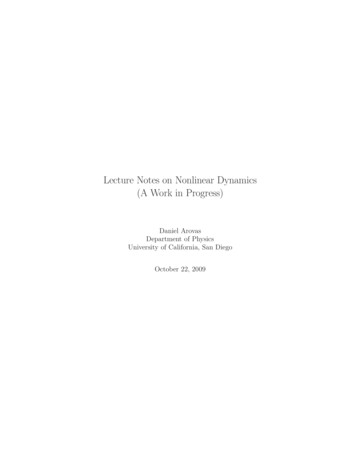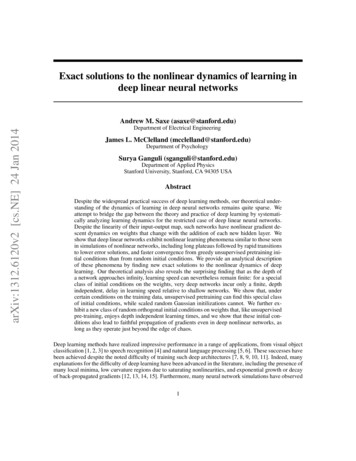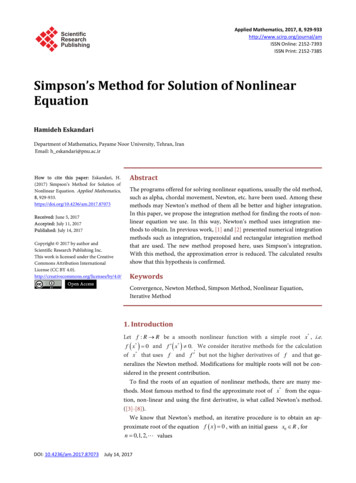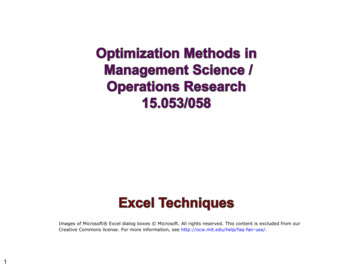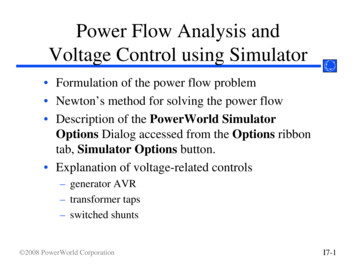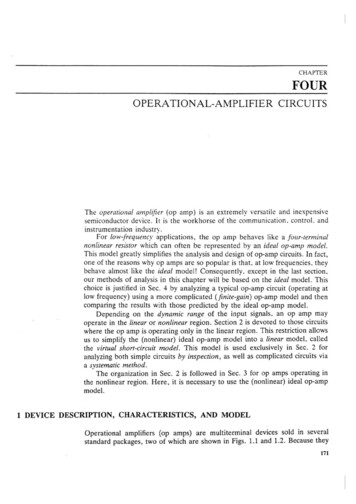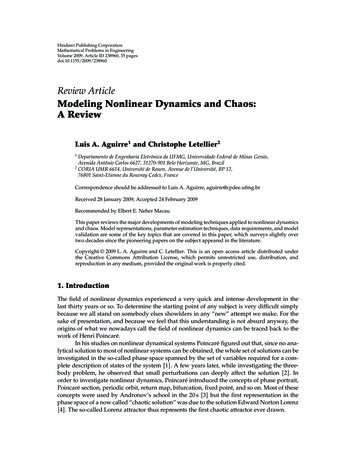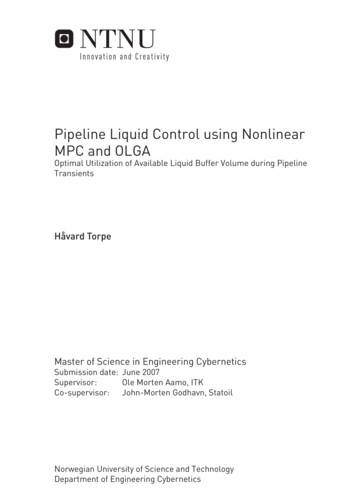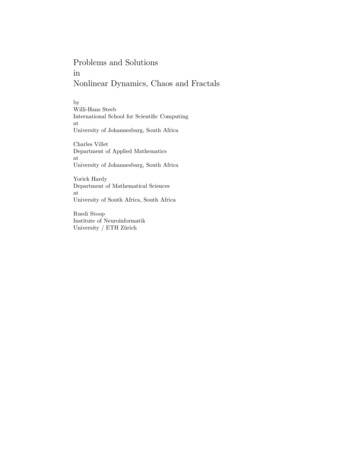
Transcription
Problems and SolutionsinNonlinear Dynamics, Chaos and FractalsbyWilli-Hans SteebInternational School for Scientific ComputingatUniversity of Johannesburg, South AfricaCharles VilletDepartment of Applied MathematicsatUniversity of Johannesburg, South AfricaYorick HardyDepartment of Mathematical SciencesatUniversity of South Africa, South AfricaRuedi StoopInstitute of NeuroinformatikUniversity / ETH Zürich
Contents1 One-Dimensional Maps1.1 Notations and Definitions . . . .1.2 One-Dimensional Maps . . . . . .1.2.1 Solved Problems . . . . .1.2.2 Supplementary Problems2 Higher-Dimensional Maps and2.1 Introduction . . . . . . . . . .2.2 Two-Dimensional Maps . . .2.2.1 Solved Problems . . .2.3 Complex Maps . . . . . . . .2.3.1 Solved Problems . . .2.4 Higher Dimensional Maps . .2.4.1 Solved Problems . . .2.5 Bitwise Problems . . . . . . .2.6 Supplementary Problems . . .Complex. . . . . . . . . . . . . . . . . . . . . . . . . . . . . . . . . . . . . . . . . . . . . .116637Maps. . . . . . . . . . . . . . . . . . . . . . . . . . . .48484949848591919497.3 Fractals103Bibliography126Index139vi
Chapter 1One-Dimensional Maps1.1Notations and DefinitionsWe consider exercises for nonlinear one-dimensional maps. In particular weconsider one-dimensional maps with chaotic behaviour. We first summarize the relevant definitions such as fixed points, stability, periodic orbit,Ljapunov exponent, invariant density, topologically conjugacy, etc. Ergodic maps are also considered.We use the notation f : D C to indicate that a function f with domainD and codomain C. The notation f : D D indicates that the domainand codomain of the function are the same set.We also use the following two definitions: A mapping g : A 7 B is calledsurjective if g(A) B. A mapping g is called injective (one-to-one) when a, a0 A, g(a) g(a0 ) a a0 . If a the mapping f is surjective andinjective the mapping f is called bijective.Definition. If B C, then f 1 (B) is called the inverse image or preimageof B and consists of all elements of D whose image is contained in B. Thatisf 1 (B) : { x D : f (x) B }.Thus the use of the notation f 1 does not necessarily imply that f is aninvertible function.1
2 Problems and SolutionsDefinition. Consider a map f : S S. A point x S is called a fixedpoint of f iff (x ) x Definition. Let f : A A and g : B B be two maps. The maps f andg are said to be topologically conjugate if there exists a homeomorphismh : A B such that, h f g h.Definition. Consider a map f : S S. A point x S is an eventuallyfixed point of the function, if there exists N N such thatf (n 1) (x) f (n) (x)whenever n N . The point x is eventually periodic with period k, if thereexists N such that f (n k) (x) f (n) (x) whenever n N .Definition. Let f be a function and p be a periodic point of f with primeperiod k. Then the point x is forward asymptotic to p if the sequencex,f (k) (x),f (2k) (x),f (3k) (x), . . .converges to p. In other words,lim f (nk) (x) p.n Definition. The stable set of p, denoted by W s (p), consists of all pointswhich are forward asymptotic to p. If the sequence x , f (x) , f (2) (x) , f (3) (x) , . . .grows without bound, then x is forward asymptotic to . The stable set of , denoted by W s ( ), consists of all points which are forward asymptoticto .Definition. Let p be a periodic point of the differentiable function f withprime period k. Then p is a hyperbolic periodic point ifdf (k)(x p) 6 1.dxIfdf (k)(x p) 1dxthen p is a nonhyperbolic periodic point.
One-Dimensional Maps3Definition. Let f be a map of an interval into itself. Consider the onedimensional difference equationxt 1 f (xt ),t 0, 1, 2, . . .with chaotic behaviour. Assume that in its chaotic regime the map f has aunique invariant measure which is absolutely continuous with respect to theLebesgue measure. By virtue of ergodicity, the invariant density, denotedby ρ, is determined as a unique solution to the equationZρ(x) dyδ(x f (y))ρ(x).IThis equation is called the Frobenius-Perron integral equation.Definition. Consider one-dimensional maps f : I I. We assume that fis differentiable. One defines the average rate of growth asλ(x0 , δx0 ) limn 1ln Dx(0) f (n) δx(0) nwhere δx satisfies the variational equation. By a theorem of Oseledec, thislimit exists for almost all x(0) with respect to the invariant measure. Theaverage expansion value depends on the direction of the initial perturbationδx(0), as well on x(0). If the invariant measure is ergodic, the largest λ withrespect to changes of δx(0) is independent of x(0), µ-almost everywhere.The number λ1 is called the largest Liapunov exponent of the map f withrespect to the measure µ.Definition. The topological entropy, H(f ) gives a measure of the numberof distinct trajectories generated by a map f . Unlike the metric entropy,h(µ, f ), the topological entropy is a property of f alone and is not associatedwith any metric properties of the dynamics. It provides a measure of thenumber of trajectories, or orbits, {x, f (x), f (2) (x) . . .} the map f has. Thisappears to be infinite, like the number of choices for x. However, orbits{x, f (x), f (2) (x) . . .} and {y, f (y), f (2) (y) . . .} are only considered distinctif f (k) (x) f (k) (y) for some k 0.If one observes up to the nth iterate there will now only exist an enumerablenumber of orbits. If m( , n) is the maximum number of different orbits (thatis trajectories separated by greater than ) of length n, the topologicalentropy is defined as a measure of the exponential growth of M with n inthe limit of arbitrarily fine discrimination between trajectoriesH lim lim 0 n 1ln M (n, ).n
4 Problems and SolutionsThis indicates M exp(Hn) in the limit. The topological entropy givesthe rate of growth of orbits with finite length as their allowed length goesto infinity (n ) and resolution fidelity becomes arbitrarily fine ( 0).The topological entropy is also determined by the number of fixed pointsof f (n) , and the following is equivalentH(f ) limn 1ln(number of fixed points under the mapf (n) ).nThere is a close relationship between Kolmogorov’s metric entropy, h(µ, f ),and the topological entropy. In particular, if f preserves several finiteinvariant measures µi , then a metric entropy hi (µi , f ) can be associatedwith each. The topological entropy can be shown to be equal to the largestmetric entropy and the corresponding maximal measure is referred to asthe Gibbs measure,H(f ) sup{h(µ, f )}.µIf f preserves a unique invariant measure, then h and H will be equal.An important feature of both the metric and topological entropies is theirstable character. If one slightly alters some parameter determining the evolution of a chaotic dynamical system, a large change in its behaviour willgenerally result because of its exponental trajectory instability.Definition. Suppose µ is invariant with respect to the map f , then themetric entropy h(µ, f ) is defined as follows:let α {Ai } and β {Bi } (i 1, 2, . . . n(α) or n(β)) be partitions of thephase space I and let α(n) be defined asα(n) n 1f i (α)i 0where f(α) is a partition of I into f ( i) (A1 ), f ( i) (A2 ), . . ., f i (An(α) )and α β is the partition of I into the sets Ai Bj with independent i andj. The entropy of the partition α is defined as Hµ (α) where( i)n(α)Hµ (α) : Xµ(Ai ) ln µ(Ai ).i 1The entropy per unit step-length of the partition α is defined ashα (µ, f ) : limn 1Hµ (α(n))nand the metric entropy is defined ash(µ, f ) : sup hα (f, µ)
One-Dimensional Maps5where the supremum is taken over all finite (or countable), measurablepartitons of the phase space. We call a partition a generator if the diametersof the members of α(n) tend to zero as n . If α is a generator thenh(f, µ) hα (f, µ).
6 Problems and Solutions1.21.2.1One-Dimensional MapsSolved ProblemsProblem 1.Consider the analytic function f : R Rf (x) 4x(1 x).(i) The fixed points of the function f are the solutions of the equationf (x ) x . Find the fixed points.(ii) The critical points of f are the solutions of the equation df (x)/dx 0.Find the critical points of f . If there are critical points determine whetherthey relate to minima or maxima.(iii) The roots of the function f are the solutions of f (x) 0. Find theroots of f .(iv) Find the fixed points of the analytic function g(x) f (f (x)).(v) Find the critical points of the analytic function g(x) f (f (x)). Ifthere are critical points of g determine whether they relate to minima andmaxima.(vi) Find the roots of the analytic function g(x) f (f (x)).If x [0, 1], then f (x) [0, 1]. So the function f could be restricted tof : [0, 1] [0, 1].Problem 2. Let f : R R be a continuosly differentiable map. Let f (n)be the n-th iterate of f .(i) Calculate the derivative of f (n) at x0 .(ii) Apply it to f (x) 2x(1 x).Problem 3.Consider the analytic function f : R R53f (x) x2 x 1.22(i) Find the fixed points.(ii) Show that { 0, 1, 2 } form an orbit of period three.Problem 4. Let f : Z Z with f (n) n 1 .(i) Show that 0 and 1 form a periodic cycle.(ii) Show that n 2 is eventually periodic.(iii) Show that every integer is eventually periodic.(iv) Does the map f admit a fixed point?Problem 5.Let g : Z Zg(n) n2 1 .
One-Dimensional Maps7(i) Find g(0), g(g(0)). Discuss.(ii) Find the fixed points of g. Find the fixed points of g g.Problem 6. (i) Consider the negation map f : R R, i.e. f (x) x.Find all fixed points. Find all its periodic points.(ii) Let g : R R with g(x) x3 . Show that g has a fixed point at 0and a periodic cycle consisting of 1 and 1. Find the stable set.Problem 7. Give an analytic map f : R R which is eventually periodic.Problem 8. (i) Consider the cubic map f : R R with f (x) x3 . Findall its periodic points and the stable set of each.(ii) Consider the map f : R R defined by f (x) x3 . Calculate theiterate f (n) (x). Assume that x ( 1, 1). Find limn f (n) (x).Problem 9.Consider the function f : R Rf (x) x x .(i) Is the function differentiable? If so find the derivative.(ii) Find the fixed points of the function and study their stability.Problem 10.(i) Show that the analytic function f : R R,f (x) sin(x)admits the fixed point x 0. Study the stability of this fixed point.(ii) Show that the analytic function f : R R,f (x) sinh(x)admits the fixed point x 0. Study the stability of this fixed point.(iii) Show that the analytic function f : R R,f (x) tanh(x)admits the fixed point x 0. Study the stability of this fixed point.Hint. Let f : R R be an analytic function and x be a fixed point, i.e.x f (x ). The fixed point x is called non-hyperbolic if f 0 (x x ) 1where 0 denotes derivative. If f 0 (x x ) 1, then three cases haveto be studied: (i) If f 00 (x x ) 6 0, then the fixed point x is semiasymptotically from the left if f 00 (x x ) 0 and from the right if
8 Problems and Solutionsf 00 (x x ) 0. (ii) If f 00 (x x ) 0 and f 000 (x x ) 0, thenthe fixed point x is asymptotically stable. (iii) If f 00 (x x ) 0 andf 000 (x x ), then x is unstable.If f 0 (x x ) 1, then two cases have to be studied: (i) If Sf (x x ) 0, then the fixed point is asymptotically stable. (ii) If Sf (x x ) 0,then the fixed point x is unstable. Here Sf (x) denotes the Schwarzianderivative defined by 2f 000 (x) 3 f 00 (x) .Sf (x) : 00f (x)2 f 0 (x)Problem 11. Give examples of maps f : [0, 1] [0, 1] where f is 1 to 1and monotone on the interval [0, 0.5] and satisfy the conditionsf (0) 0,f (0.5) 1,f (1) 0,f (x) f (1 x).Problem 12. Can one find polynomials p : R R such that one criticalpoint of p and one fixed point of p coincide? Start of withp(x) cn xn cn 1 xn 1 · · · c1 x c0(1)where n 2.Problem 13. Let f1 : R R, f2 : R R be continuous function.Assume that x 0 is a fixed point of both f1 and f2 . Let g1 (x) f1 (f2 (x))and g2 (x) f2 (f1 (x)). Show that the functions h1 (x) g1 (x) g2 (x) andh2 (x) g1 (x) g2 (x) also admit this fixed point.Problem 14.Let a 6 0. Consider the polynomialsf (x) ax3 bx2 cx d,g(x) x3 Ax Bwith A 9ac 3b2 , B 27a2 d 2b3 9abc.(i) Find (Newton map)Nf (x) x f (x),f 0 (x)Ng (x) x g(x).g 0 (x)(ii) Let h(x) 3ax b. Show that h Nf Ng h.Problem 15. Let n N. Consider the map (Newton’s method to find thesquare root of n) 1nxt 1 xt ,t 0, 1, 2, . . .2xt
One-Dimensional Maps9given the initial value x0 with x0 0.(i) Find the fixed points.(ii) Show that 2xt 1 nxt n .xt 1 nxt n(iii) Find limt xt .Problem 16.Let r 0. Find the first iterate of the Newton mapr 1 x .fr (x) 2xProblem 17.Newton’s sequence takes the form of a difference equationxt 1 xt f (xt )f 0 (xt )where t 0, 1, 2, . . . and x0 is the initial value at t 0. Let f : R R begiven byf (x) x2 1and x0 6 0.(i) Find the fixed points of f .(ii) Find the fixed points of the difference equation.(iii) Find the exact solution of 11xt 1 xt .2xt(iv) Let x0 1/2. Find x1 , x2 and x3 .Problem 18. Let f : R R be a positive, continously differentiablefunction, defined for all real numbers and whose derivative is always negative. Show that for any real number x0 (initial value) the sequence (xk )obtained by Newton’s methodxt 1 xt f (xt )f 0 (xt )t 0, 1, 2, . . .has always limit .Problem 19.Consider the function f : [0, 1] [0, 1]f (x) 1 1 sin(2πx).2 2
10 Problems and SolutionsFind the fixed points and study their stability.Problem 20. Let f : R R, g : R R be analytic functions with thesame fixed point x , i.e. f (x ) x , g(x ) x . Show that f g and g fadmit this fixed point.Problem 21. Consider the polynomial f (x) x3 3x 3. Show that forany positive integer N , there is an initial value x0 such that the sequencex0 , x1 , x2 , . . . obtained from Newton’s methodxt 1 xt f (xt )2x3t 3 ,f 0 (xt )3(x2t 1)t 0, 1, 2, . . .has period N .Problem 22.Let x 0 and p 0. Consider the mapf (x) xep x .(i) Find the fixed points. Study the stability of the fixed points.(ii) Show that f has a least one periodic point x with x 6 0 or p.Problem 23.Consider the analytic function f : R Rf (x) 2x(1 x).(i) Find the fixed points. Are the fixed points stable?(ii) Calculatelim f (n) (1/3).n Discuss.(iii) Let n be a positive integer n with n 2. Find the distances 1/n 1/(n 1) and f (1/n) f (1/(n 1)) .Discuss.Problem 24.Consider the logistic map f : [0, 1] [0, 1]f (x) 4x(1 x).(i) Find the fixed points.(ii) Let xe 3/4. Find the preimage.(iii) Let xe 0. Find the preimage.(iv) Let xe 1/2. Find the preimage.
One-Dimensional Maps11(v) Let n be an integer with n 3. Show that11 f (1/n) f (1/(n 1)) . n n 1Problem 25.Consider the logistic maps fr : R R given byfr (x) rx(1 x),r 0.(i) Find the fixed points of fr .(ii) Establish for which values of the bifurcation parameter r the fixed pointsof fr are attrative(iii) Find the the periodic points of prime period 2 for fr . In both cases,establish for which values of r the points will occur.(iv) Establish for which values the periodic points of prime period 2 areattractive.Problem 26.Consider the logistic family fr : R R given byfr (x) rx(1 x).Show that there exists an infinite number of eventually fixed points forr 4.Problem 27. The logistic family fr : R R is defined by fr (x) rx(1 x).(i) Show that fr undergoes a period-doubling bifurcation.(ii) Find the values of x and µ the period doubling occurs.For fr to undergo a period-doubling bifurcation for x x0 , r r0 , it mustsatisfy the following four conditions.(i) fr0 (x0 ) x0(ii) fr0 0 (x0 ) 1(2)(iii) (fr )0 (x0 ) r(iv) fr0000 (x0 ) 6 Problem 28.6 0r r0 23 [fr00 (x0 )]2 .The family of quadratic maps fr : R R is defined byfr (x) x2 r.Find out whether fr undergoes a tangent bifurcation, and if so, for whichvalues of x and r it occurs.
12 Problems and SolutionsFor fr to undergo a tangent bifurcation for x x0 , r r0 , it must satisfythe following four conditions.(i) fr0 (x0 ) x0(ii) fr0 0 (x0 ) 1(iii) fr000 (x0 ) 6 0 fr (x0 )6 0(iv) rr r0Problem 29.The family of quadratic maps gr : R R is defined bygr (x) x2 r.(i) Establish for which values of r the quadratic map is topologically conjugate to the logistic map fµ (x) µx(1 x), µ 0.(ii) Make use of the topological conjugacy in order to establish for whichvalues of r, gr will have a single attractive fixed point.(iii) What happens if r 34 ?(iv) Can any conclusions be drawn about the dynamics of gr if r 1/4?Problem 30.The tent map T : [0, 1] [0, 1] is defined by 2x for x [0, 21 ] T (x) 2 2x for x [ 12 , 1].(i) Sketch the graph of the tent map T . Draw the line f (x) x for x [0, 1]to locate the fixed points. Find the fixed points.(ii) Sketch the graph for the second iterate T (2) of the tent map T . Drawthe line the locate the fixed points.(iii) Let T (n) be the n-th iterate. Show that T (n) has 2n repelling periodicpoints of period n.(iv) Show that these periodic points are dense on [0, 1].Problem 31.The tent map T : [0, 1] [0, 1] is defined by 2x for x [0, 12 ] T (x) 2 2x for x [ 12 , 1].Show that the maph(x) 11πcos[π(1 x)] cos2 [ (1 x)]222is a topological conjugacy between f (x) 4x(1 x) and the tent map.
One-Dimensional Maps13Problem 32. Let (s0 , s1 , ., sn 1 )T Rn , where n 2k . This vector inRn can be associated with a piecewise constant function f defined on [0, 1)f (x) k2X 1sj Θ[j2 k ,(j 1)2 k ) (x)j 0where Θ[j2 k ,(j 1)2 k ) (x) is the step function 1 x [j2 k , (j 1)2 k )Θ[j2 k ,(j 1)2 k ) (x) : 0x / [j2 k , (j 1)2 k )with the support [j2 k , (j 1)2 k ). Consider the logistic map xj 1 4xj (1 xj ) with j 0, 1, 2, . . . and x0 1/3. Thenx0 1,3x1 8,9x2 32,81x3 6272.6561Find f (x) for this data set and then calculateZ 1f (x)dx.0Problem 33.Consider the function f : [0, ) [0, )f (x) x4 e xor written as difference equationxt 1 x4t e xt ,t 0, 1, 2, . . .with x0 0.(i) Find the fixed points of f and study their stability.(ii) Find the maxima and minima of the function f .Problem 34.Consider the map f : [0, π] [0, 2] defined byf (x) 2 sin(x).Show that the map has two fixed points. Are these fixed point hyperbolicfixed points?Problem 35.[0, 1]Consider the symmetric tent map f on the unit interval f (x) 2x if x 1/22 2x if x 1/2
14 Problems and SolutionsThe map is chaotic and completely mixing. It als has a unique absolutelycontinuous invariant measure and cycles of all orders. Let N be a positiveinteger. As a discrete model g of f consider the restriction of f on theN -digital binary lattice 2N 11 2 3.LN 0, N , N , N , . . . ,2 2 32NShow that g is asymptotically trivial.Problem 36.Let f : [0, 1) [0, 1). The Bernoulli map is defined byf (x) : 2x mod 1.The map can be written as a difference equation 2xtfor 0 xt 1/2xt 1 (2xt 1) for 1/2 xt 1(2)where t 0, 1, 2, . . . and x0 [0, 1).(i) Find the fixed points.(ii) Study the stability of the fixed points.(iii) Find a periodic orbit.(iv) Find the exact solution.(v) Evaluate the Ljapunov exponent.(vi) Find the invariant density.(vii) Evaluate the autocorrelation function.Problem 37.Consider the first-order discrete time dynamical systemxt 1 2xtandmod 1 st t 0, 1, 2, . . .1 if xt 0.50 if xt 0.5where x0 [0, 1]. We call s s0 s1 s2 . . . the output symbol. Show that ifx0 [0.78125, 0.8125] then the output coincide for the first three bits.Problem 38.The logistic map is given byxt 1 4xt (1 xt ),t 0, 1, . . .(1)where x0 [0, 1]. It can also be considered as a map f : [0, 1] [0, 1],f (x) 4x(1 x).(i) Show that xt [0, 1] for t 1, 2, .
One-Dimensional Maps15(ii) Find the fixed points of the equation.(iii) Give the variational equation.(iv) Show that the fixed points are unstable. Hint. Show thatdf (x)dx 1.(2)x x (v) Find the periodic orbits.(vi) Show that the exact solution of (1) is given byxt 1 1 cos(2t arccos(1 2x0 )).2 2(3)where x0 [0, 1] is the initial value.(vii) Show that for the initial valuesx0 rπ 1 1 cos s2 22(4)where r and s are integers we find that the orbits are periodic or tend to afixed point.(viii) Show that for allmost all initial values we find that the autocorrelationfunction is given by 1forτ 0Cxx (τ ) 8(5)0 otherwise(ix) Show that the invariant density is given byρ(x) 1πpx(1 x).(x) Show that for almost all initial values the Ljapunov exponent λ for thelogistic map (1) is given byλ ln(2).Problem 39.(i) Let f : [ 1, 1] 7 [ 1, 1] be defined byf (x) : 1 2x2 .(1)Let 1 a b 1 andµ([a, b]) : Calculate µ([ 1, 1]).1πZab dx.1 x2(2)
16 Problems and Solutions(ii) Show thatµ(f 1 ([a, b])) µ([a, b])(3)where f 1 ([a, b]) denotes the set S which is mapped under f to [a, b], i. e.f (S) [a, b]. The quantity µ is called the invariant measure of the map f .(iii) Let g : [0, 1] 7 [0, 1] be defined by 2x 0 x 1/2g(x) : (4)2(1 x) 1/2 x 1This map is called the tent map. Let 0 a b 1 andZ bdx.ν([a, b]) : aShow thatν(g 1 ([a, b])) ν([a, b])where g 1 ([a, b]) is the set S which is mapped under g to [a, b], i. e. g(S) [a, b].(iv) Find the Lyapunov exponent of the tent map (4).Problem 40. The Chebyshev polynomials of first kind can be defined as(n 0, 1, 2, . . .) n n pp1 x x2 1 x x2 12 bn2c Xnn(1 x 2 )k x2kTn (x) k 0or as the recurrence relation (n 1, 2, . . .)Tn 1 (x) 2xTn (x) Tn 1 (x)with T0 (x) 1, T1 (x) x.(i) Find T2 and T3 .(ii) Find Tn (Tm (x)).(iii) Find the fixed points of T3 and study whether they are stable.Problem 41.Consider the cubic map fr : [ 1, 1] [ 1, 1]fr (x) rx3 (1 r)x,r [3.2, 4.0](i) Find the fixed points and study their stability.(ii) Find the critical points of the map fr in the interval [ 1, 1] and testwhether we have a minimum or maximum.
One-Dimensional Maps17(iii) Find the linearized map (variational equation)(iv) Find the exact solution for the case r 4.Problem 42.Consider the piecewise linear map f : [0, 1] [0, 1] 3x for 0 x 1/3f (x) 2 3x for 1/3 x 2/3 3x 2 for 2/3 x 1.(i) Find the fixed points and study their stability.(ii) Find f (1/2), f (f (1/2)), f (f (f (1/2))).(iii) Find f (1/3), f (f (1/3)), f (f (f (1/3))).Problem 43.Consider the piecewise linear map f : [0, 1] [0, 1]. 4x for 0 x 1/4 4x 1 for 1/4 x 1/2f (x) 4x 3 for 1/2 x 3/4 4x 4 for 3/4 x 1.(i) Find the fixed points and study their stability.(ii) Find f (1/2), f (f (1/2)), f (f (f (1/2))).(iii) Find f (1/3), f (f (1/3)), f (f (f (1/3))).Problem 44.Consider the map f : [0, 1] [0, 1] given by 7x/5for x [0, 1/2]f (x) 14x(1 x)/5 for x [1/2, 1].Find a lower as well as an upper limit for the value of the Liapunov exponent.Problem 45.Consider the logistic maps f : [0, 1] [0, 1]f (x) 4x(1 x)and φ : [0, 1] [0, 1]φ(x) 2arcsin x.π(i) Show that f and φ are continuous.(ii) Show that φ is a homeomorphism andφ 1 (x) sin2 πx 2 1 cos(πx).2
18 Problems and Solutions(iii) Let g : [0, 1] [0, 1] be defined by 2xfor x [0, 21 ]g(x) 2(1 x) for x [ 12 , 1]Show thatg(x) (φ f φ 1 )(x).The maps f and g are called topologically conjugacy.Problem 46.Consider the tent map given by 2xfor 0 x 1/2f (x) 2(1 x) for 1/2 x 1.(1)The Frobenius-Perron integral equation is given byZ 1ρ(x) ρ(y)δ(x f (y))dy.(2)0Find ρ for the tent map.Problem 47.Consider the map f : [ 1, 1] [ 1, 1] withf (x) 1 2 x r .(1)This map is a fully developed chaotic map for r 21 . The Frobenius-Perronintegral equationZ1ρ(y)δ(x f (y))dyρ(x) (2)0becomes1ρ(x) 2r 1 x2 (1 r)/r " ρ1 x2 1/r ! ρ 1 x2 1/r !#.(3)Find the invariant density for r 1, r 1/2 and r 2.Problem 48. Let Σ be the set of all infinite sequences of 0’s and 1’s.This set is called the sequence space of 0 and 1 or the symbol space of 0and 1. More precislyΣ : { (s0 s1 s2 . . .) : si 0 or 1}(1)Let s s0 s1 s2 . . . and t t0 t1 t2 . . . be elements in Σ. We denote thedistance between s and t as d[s, t] and define it byd[s, t] : X si ti i 02i.(2)
One-Dimensional Maps19(i) Show that X10 d[s, t] 2.i2i 0(3)Note that si ti is either 0 or 1.(ii) Show that the distance bewteen s 0000 . . . and t 01010101010 . . .is 2/3.(iii) Let s and t be elements of Σ. Show that if the first n 1 digits in sand t are identical, then d[s, t] 1/2n . Show that if d[s, t] 1/2n , thenthe first n digits in s and t are identical.Problem 49.Let 0 r 1. Consider the map fr : [0, 1] [0, 1] x/rfor 0 x rfr (x) (x r)/(1 r) for r x 1Find the Liapunov exponent.Problem 50. Let Σ be the set of all bi-infinite sequences of the binarysymbols {0, 1}, i.e.Σ : { σ : σ : Z {0, 1} }.(1)The elements, σ of Σ are called symbol sequences and they are defined byspecifying σ(n) σn {0, 1} for each n Z. We writeσ : {σn } n {. . . σ 2 σ 1 · σ0 σ1 σ2 . . .}(2)We consider the dynamics of the map f : Σ Σ defined byf (σ)n : σn 1(3)n Z. This is known as a left-shift on Σ because it corresponds to movingthe binary point one symbol to the left. Show that the left shift f : Σ Σhas periodic orbits of all period as well as aperiodic orbits.Problem 51.Show that the mapf (x) x rmod 1(1)is not ergodic when r is rational. This means r k/m, where k Z,m Z \ {0}.Problem 52.Consider the map (so-called Mixmaster return map) 1xn 1 f (xn ) x 1n bxn c(1)
20 Problems and Solutionswhere f (0) 0 and f : [0, 1] [0, 1]. In analytic form this return map isthe single-valued function,f (x) x 1 k,(k 1) 1 x k 1 ;k Z .(2)The function possesses an infinite number of discontinuties and is not injective since each x0 has a countable infinity of inverse images, one on eachinterval [(k 1) 1 , k 1 ] for integral k.(i) Show that the return mapping is expansive, f 0 (x) 1(3)on x (0, 1), everywhere.(ii) Show that all the fixed points (f (x ) x ) are unstable.(iii) Find the invariant measure.(iv) Find the metric entropy.Problem 53. We consider one-dimensional smooth maps. Show that theLyapunov exponents are invariant under conjugation.Problem 54.jugation.Show that the topological entropy is invariant under con-Problem 55. Consider the unimodal map f : [0, 1] [0, 1]. We assumethat f is continuous and reaches its maximal value at an interior point cof I. The point c is called the critical point of f . In both subintervalsdivided by c, [0, c) and (c, 1], the map f is strictly monotonic. We assumethat f (0) f (1) 0. A discrete dynamical systemxt 1 f (xt ),t 0, 1, 2, . . .is defined from f by iteration. Given a starting point x0 I, we use thenotation(x0 , x1 , · · · , xt , · · ·)to denote the orbit from x0 . Using the coarse-grained description 0 for x cA(x) : c for x c 1 for x cwe transform the orbit (x0 , x1 , x2 , . . .) into an itinerary, that is,I(x) (A(x0 ), A(x1 ), . . . , A(xt ), . . .)which is an infinite string over the alphabet {0, c, 1}. The kneading sequenceof the unimodal map f is the itinerary I(f (c)), which decides nearly allother itineraries a given map f can have.
One-Dimensional Maps21(i) Show that the logistic map f (x) 4x(1 x) is a unimodular map.(ii) Obviously, c 1/2 is a critical point of the map. Find a preimage ofthe map.(iii) Find the orbit in the coarse-grained description for the initial valuex0 1/3.(iv) Find the kneading sequence.Problem 56. To construct the symbolic dynamics of a dynamical system,the determination of the partition and the ordering rules for the underlyingsymbolic sequences is of crucial importance. For one-dimensional mappings, the partition is composed of all the critical points. Consider theantisymmetric cubic map f : [ 1, 1] [ 1, 1] (t 0, 1, 2, . . .)xt 1 f (xt ) rx3t (1 r)xt ,r [1, 4].(1)(i) Find the critical points of f . We denote the critical points by C and C̄.(ii) Show that the ternary partition marked by C̄ and C divides the interval[ 1, 1] into three monotonic branches.(iii) The right branch to C is assigned 0, the left branch to C̄ is assigned 2,whereas the part between C̄ and C is 1. Show that nearly all trajectoriesare unambiguously encoded by infinite strings of bits S(x) (s1 s2 · · ·),where si is either 0, 1 or 2.(iv) Referring to the natural ordering of the real numbers in the interval[ 1, 1], show that the ordering rules for these symbolic strings can be defined, that is, considering two symbolic strings S(x1 ) and S(x2 ) from theinitial points x1 and x2 , S(x1 ) S(x2 ) if and only if x1 x2 .(v) Find the kneading sequence Kg and Ks (i.e. the forward symbolicsequences from the maximal and minimal values C̄ and C).Problem 57.(0, 1))Consider the the family of maps fr : [0, 1] [0, 1] (r (xfr (x) xr,1 x1 r , x (0, r), (r, 1].(i) Show that for each r we have constant invariant density ρ(x) 1.(ii) Show that this can be used to calculate the Liapunov exponent λrλr (r 1) ln(1 r) r ln r.Problem 58.The Bernoulli map f : [0, 1) [0, 1) is given byf (x) 2x mod 1.(1)
22 Problems and SolutionsWe consider the time evolution of a probability density ρn (x) (a ”state”)describing an ensemble of trajectories. The Frobenius-Perron integral equation is given byZ1ρ(y)δ(x f (y))dy.ρ(x) 0Thus the time evolution of a state ρ(x) under f is given by the FrobeniusPerron operator U , defined by 111ρnx ρn(x 1).ρn 1 (x) U ρn (x) : 222Since ρ is a probability density, it should be integrable, we require it tobe in the Banach space L1 (0, 1) of Lebesgue integrable functions on [0, 1].However, it is common to restrict ρ to
Problems and Solutions in Nonlinear Dynamics, Chaos and Fractals by Willi-Hans Steeb International School for Scienti c Computing at University of Johannesburg, South Africa Charles Villet Department of Applied Mathematics at University of Johannesburg, South Africa Yorick Hardy Department of Mathematical Sciences at University of South Africa .
